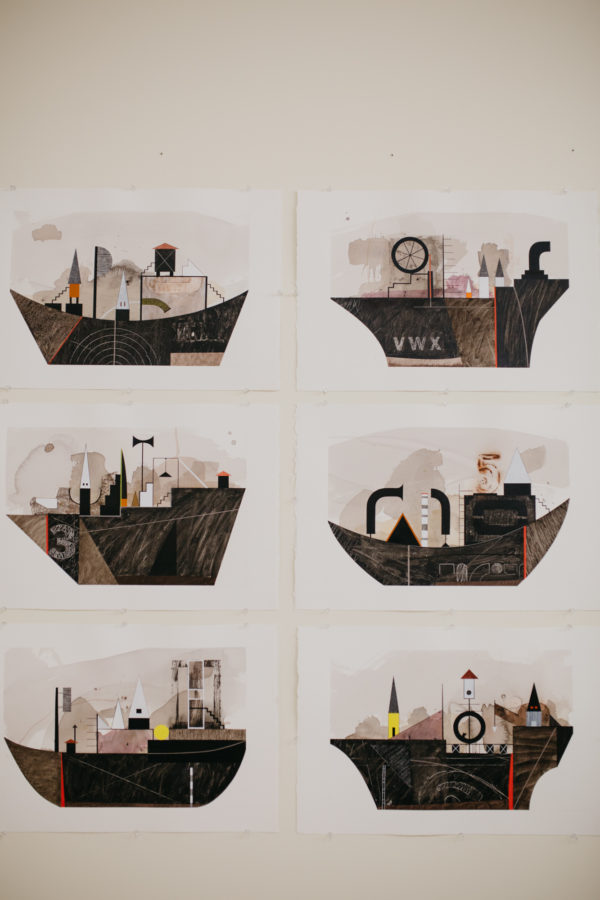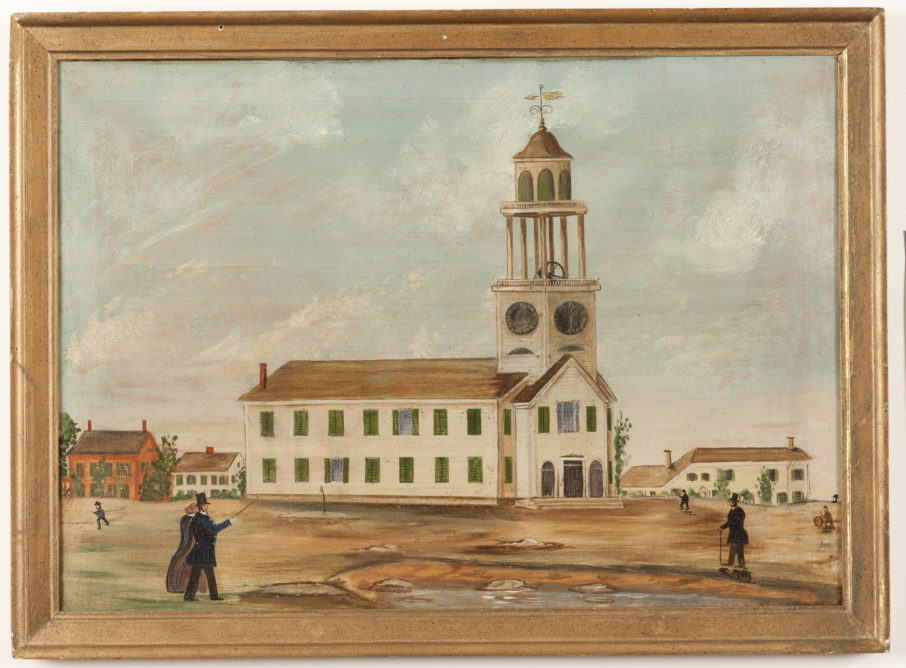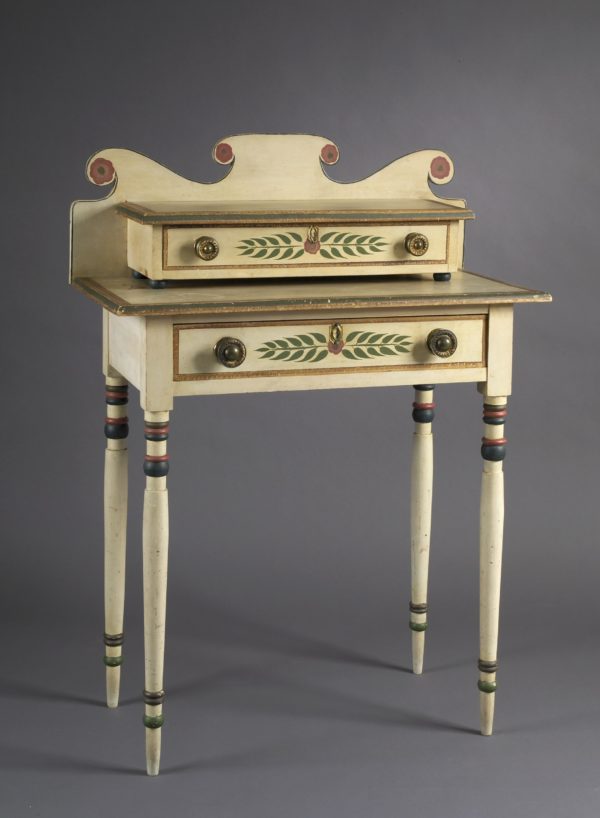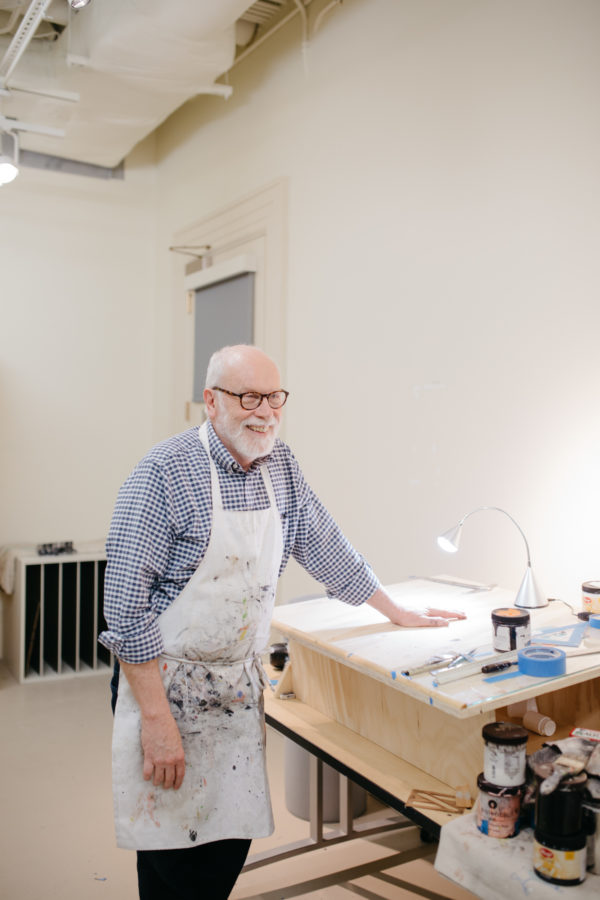I arrived at the Gibbes on February 28. Though my proposal for the Visiting Artist program suggested that I would use elements of the exhibition A Shared Legacy: Folk Art in America as points of departure for my own work during my Gibbes residency, I had no idea what I would actually do upon my arrival. Regardless, I came to Charleston with sixteen prepared white canvases, my drawing and painting tools, and a selection of limited palette paints. My goal was to make two new series of paintings that would somehow be informed by my stay in Charleston, A Shared Legacy, and my general interest in the work of self-taught artists.
One of my first orders of business was to install the sixteen canvases on the wall in Studio One, my work-space for the next five weeks. As I worked on the canvas panels, I wanted to see them hanging together. The process that I employ allows me to move from one canvas to the next without becoming too self-conscious about any one panel. What is happening collectively on all of the panels, in terms of drawing and painting, is more important than the content on any individual canvas panel.
So, on Wednesday, February 28, there were sixteen white, blank canvases hanging on the wall and it was intimidating. Before the afternoon was out, I had covered them all with a grey, translucent acrylic. While the grey paint was still wet, I often pressed stencil forms into the paint. I marked the canvas freely, if not wildly, with brush strokes. I sprayed water on the painted canvas to create lighter areas that might drip down to the bottom of the panels. Objectively, it pretty much looked like finger painting that was accomplished without regard to what subject matter would come next. From my perspective, this was a starting point and the white canvases were in progress.

The next day I used mechanical drawing tools to begin outlining well-defined perpendicular or curved shapes onto each canvas. I used blue painter’s tape to seal off each area and then painted the shaped areas either black or white. Sometimes I would paint over the stenciled areas I had created the day before; sometimes the stencil areas would become central to the imagery, it just depended. As the days went on, two bodies of work began to emerge. One was occupied mainly by my imagination rather than observational rendering. On the other eight canvases boats or ships, together with undefined shapes, began to appear. They also seemed more free-floating than the group with the facade-like rectangles. From that point on, each series began to take on a life of its own.
As life took shape on the canvases, I continued to use mechanical drawing techniques to establish lines and shapes. A working knowledge of symmetry, measuring, geometry, silhouette, as well as line and surface quality, are some of the elements that comprise my visual vocabulary, or toolbox. The processes that emerge from this toolbox inform the visual look of my work. Different artists emphasize different tools and thus create different visual aesthetics. The tools that I use regularly have been gleaned from various life experiences, including high school drafting class, working in a machine shop, picture framing, and designing for the wall accessory industry.

As I referenced A Shared Legacy, the exhibition currently on view on the third floor of the Museum, I looked closely at several works, most notably, The Old South Church attributed to John Hilling; Steamboat “Victoria” by James Bard; and View of the Schuylkill County Almshouse Property in the Year 1881 by Ralph Reed. At the same time, furniture pieces also had a visual impact and reinforced what I was up to in Studio One on the first floor. For example, note the decorative painting on the Chest of Drawers made in Lehigh or Northumberland County, Pennsylvania; or the amazingly architectural Dressing Table made in New England 1835–40.

My daily commute has also informed the work that I’ve created while at the Gibbes. Living (albeit temporarily) within walking distance of the Museum has influenced the spirit of the work evolving in the studio – the Charleston built environment is a series of magical designs that enliven the beginning of each day as I make my way to the Gibbes.
The willingness to look and be impacted by what is around me has been crucial to my work, and especially to my time at the Gibbes in Charleston. This is a way of thinking with my eyes. Once in the studio, I then attempt to think with my hands. As a result, I hope what appears on the canvases is more immediate and authentic, providing a sense of discovery in what happens with each additional line or shape.
The time and space afforded by the Gibbes Visiting Artist program have helped rekindle aspects of my work after years as an arts administrator, gallery director, and department chair. Don’t get me wrong, I would not trade anything for those experiences, the students I served, or the colleagues I knew. But time and space in an untested environment have allowed me to reflect more closely on the process. Interacting in Studio One with folks who are interested in art and its making has enhanced my ability to communicate about my work while reconsidering visual and conceptual possibilities. Being in this space is a reminder that working every day is not only a joy, but a means to demystify the “art thing” and make it accessible for broader audiences, including those people I have met here at the Gibbes.

On April 6, my last day in residence, I intend to gather my things and the work I have made and return to Rock Hill where I will have the work photographed for my website. I hope to bring much of the work back to Charleston to the George Gallery which has provided a home for my work in this city. Then I will begin a new series that I have already imagined as a result of my residency. Still, I am happy to say, I really have no idea what I am going to do with what comes next.
— Tom Stanley, Visiting Artist and Guest Blogger
March 30, 2018
Top Image: When Tom Stanley arrived at the Gibbes, he placed sixteen prepared, white canvases on a wall in Studio One. Here, we see the previously blank canvases transformed into a dynamic collection of paintings. Photo by Lindsay Shorter.

